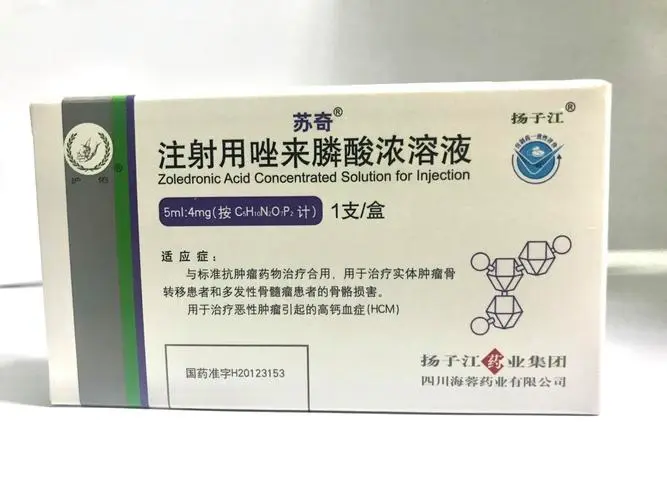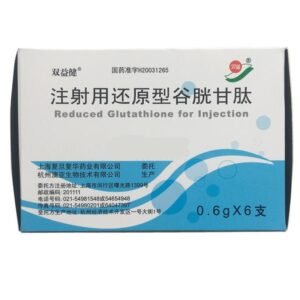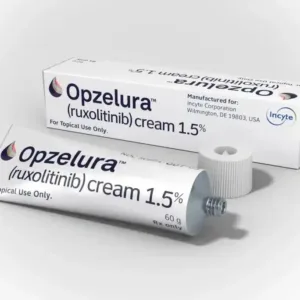Zoledronic acid Injection.
Effects and efficacy:
Combined with standard antineoplastic drugs to treat bone metastasis of solid tumors and bone damage caused by multiple myeloma. Used to treat hypercalcemia (HCM) caused by malignant tumors. Used to treat osteoporosis in postmenopausal women. Used to treat male osteoporosis to increase bone mass. Used to treat deforming osteitis (Paget’s disease).
Usage and dosage:
Bone metastasis of solid tumors and bone damage caused by multiple myeloma: intravenous drip of 4 mg once every 3 to 4 weeks. At the same time, take 500 mg of calcium and 400 U of vitamin D orally daily. HCM caused by malignant tumors: intravenous drip of 4 mg once. Re-treatment must be at least 7 to 10 days apart from the previous one. Osteoporosis in postmenopausal women or men: intravenous drip of 5 mg once a year. The optimal course of treatment is not clear, and it is necessary to re-evaluate whether to continue treatment regularly. Patients with low fracture risk should consider stopping the drug after 3 to 5 years of medication. Patients who stop treatment should re-evaluate fracture risk regularly. When calcium and vitamin D are insufficient in the diet, they should be supplemented appropriately. Paget’s disease: intravenous drip of 5 mg once. Vitamin D and adequate calcium should be supplemented within at least 10 days after medication, ensuring that at least 500 mg of calcium and vitamin D are supplemented each time, twice a day. Paget’s disease is a lifelong disease and usually requires retreatment. Re-treatment can be repeated intravenously by dripping 5 mg again after an interval of 1 year or more after the initial treatment. Dosage for renal insufficiency: Bone metastasis of solid tumors and bone damage caused by multiple myeloma: 4 mg once for those with creatinine clearance (Ccr) greater than 60 ml/min; 3.5 mg once for those with Ccr of 50-60 ml/min; 3.3 mg once for those with Ccr of 40-49 ml/min; 3 mg once for those with Ccr of 30-39 ml/min. HCM: No dose adjustment is required for those with serum creatinine less than 400 μmol/L (or 4.5 mg/dl). Postmenopausal women or men with osteoporosis and Paget’s disease: No dose adjustment is required for those with Ccr greater than or equal to 35 ml/min. Preparation method: 4 mg per dose for adults, fully dissolved in 5 ml sterile water for injection, diluted in 100 ml 0.9% sodium chloride injection or 5% glucose injection without calcium ions, slow intravenous drip time should be no less than 15 minutes. Administer once every 3 to 4 weeks or as directed by a doctor. For the treatment of osteoporosis, the recommended dose is 5 mg intravenous drip once a year. The same drugs produced by different manufacturers may have inconsistent instructions. If you find inconsistencies in the instructions before taking the drug, please consult a doctor or pharmacist in time.
Drug contraindications:
Allergy to this product is prohibited during pregnancy, lactation, and renal impairment
Related dosage forms:
Injection, powder injection
Share:
Products
Our offers
Health Classification
Let us work together to protect precious health




























